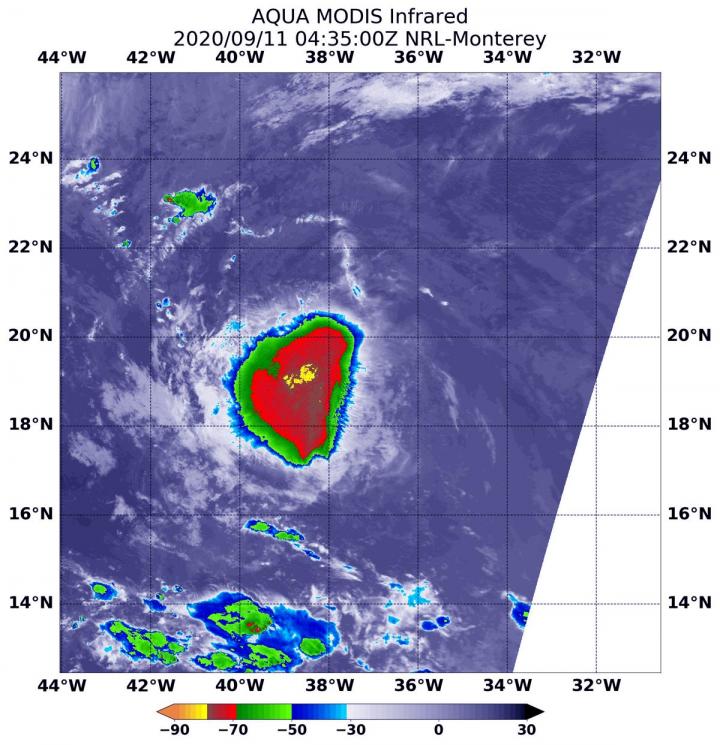
Credit: Credit: NASA/NRL
Infrared imagery from NASA’s Aqua satellite showed an elongated Tropical Storm Rene being battered by wind shear in the Central Atlantic Ocean. Tropical cyclones that appear less than round are likely being affected by wind shear or outside winds transitioning into an extra-tropical cyclone or taking on the elongated appearance of a weather front. Infrared imagery from NASA’s Aqua satellite showed an elongated Tropical Storm Rene being battered by wind shear in the Central Atlantic Ocean. Tropical cyclones that appear less than round are likely being affected by wind shear or outside winds transitioning into an extra-tropical cyclone or taking on the elongated appearance of a weather front. Outside winds have given Rene’s strongest storms an appearance like that of a triangle.
Wind Shear Affecting Rene
The shape of a tropical cyclone provides forecasters with an idea of its organization and strength. When outside winds batter a storm, it can change the storm’s shape. Winds can push most of the associated clouds and rain to one side of a storm.
In general, wind shear is a measure of how the speed and direction of winds change with altitude. Tropical cyclones are like rotating cylinders of winds. Each level needs to be stacked on top each other vertically in order for the storm to maintain strength or intensify. Wind shear occurs when winds at different levels of the atmosphere push against the rotating cylinder of winds, weakening the rotation by pushing it apart at different levels.
Infrared Data Reveals Effects of Wind Shear
NASA’s Aqua satellite uses infrared light to analyze the strength of storms by providing temperature information about the system’s clouds. The strongest thunderstorms that reach high into the atmosphere have the coldest cloud top temperatures.
On Sept. 11 at 12:35 a.m. EDT (0435 UTC), the Moderate Resolution Imaging Spectroradiometer or MODIS instrument that flies aboard NASA’s Aqua satellite revealed a small area of Rene’s most powerful thunderstorms around its center where cloud top temperatures were as cold as minus 80 degrees Fahrenheit (minus 62.2 Celsius). A larger area of strong storms with cloud top temperatures as cold as minus 70 degrees Fahrenheit (minus 56.6. degrees Celsius) surrounded the center in what looks like a triangular shape. NASA research has found that storms with cloud tops as cold as at least minus 70 degrees Fahrenheit can generate heavy rain.
At 5 a.m. EDT on Sept. 11, U.S. Navy Hurricane Specialist, Dave Roberts of NOAA’s National Hurricane Center in Miami, Fla. noted in the Rene discussion, “A microwave pass revealed that Rene’s surface center is farther separated from the shrinking deep convection. Model soundings indicate that east-southeasterly 30 to 25 knot [vertical wind] shear near 300 millibars is temporarily undercutting the diffluent southerly flow aloft.” An air pressure of 300 millibars is about 30,000 feet (9,100 meters) high in the atmosphere, but it can vary between 27,000 to 32,000 feet (8,200 to 9,600 meters).
The wind shear Rene is currently experiencing is expected to relax during the next 36 to 48 hours (from 5 a.m. EDT on Sept. 11) which should allow for gradual intensification. “By mid-period, Rene is forecast to move into an area of increasing west-northwesterly shear, which should induce a weakening trend,” Roberts noted.
Rene’s Status on Sept. 11
At 5 a.m. EDT (0900 UTC), the center of Tropical Storm Rene was located near latitude 19.7 degrees north and longitude 38.5 degrees west. Rene is 985 miles (1,585 km) west-northwest of the Cabo Verde Islands. Rene is moving toward the west-northwest near 10 mph (17 kph). This general motion is expected to continue through Friday night, followed by a turn toward the northwest on Saturday. Maximum sustained winds are near 45 mph (75 kph) with higher gusts. The estimated minimum central pressure is 1002 millibars.
Rene’s Weekend Forecast
NHC forecasters expect a north-northwestward and northward motion with a decrease in forward speed on Sunday and Sunday night [Sept. 13]. Gradual strengthening is forecast during the couple of days. Afterward, weakening is expected to begin by Sunday night.
NASA Researches Earth from Space
For more than five decades, NASA has used the vantage point of space to understand and explore our home planet, improve lives and safeguard our future. NASA brings together technology, science, and unique global Earth observations to provide societal benefits and strengthen our nation. Advancing knowledge of our home planet contributes directly to America’s leadership in space and scientific exploration.
For updated forecasts, visit: http://www.
###
Media Contact
Rob Gutro
[email protected]
Original Source
https:/




